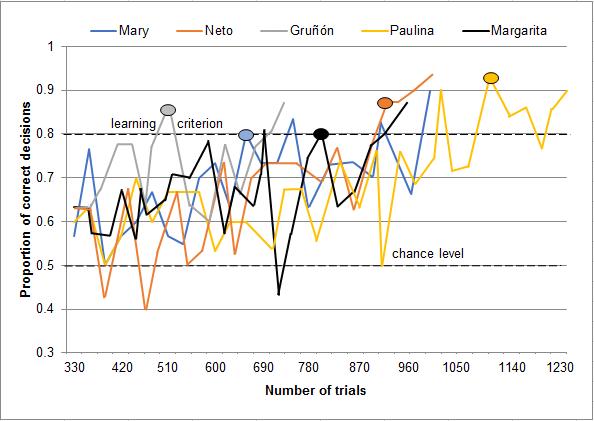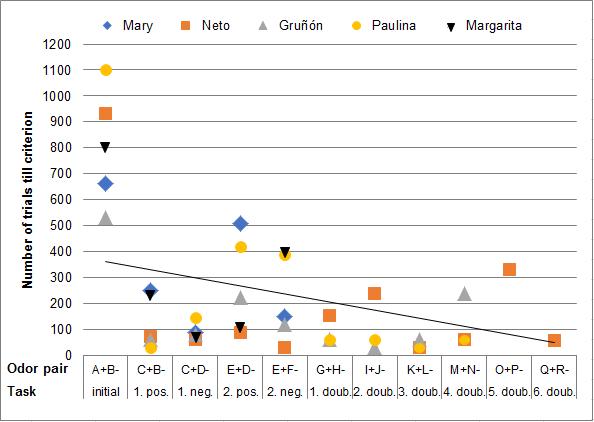Results
Pre-training
3 out of 5 individuals (Mary, Neto and Paulina) required 10 days of pre-training before starting with the actual data collection period with the initial odor pair. One male, Gruñón, only spent five days with pre-training whereas one female, Margarita, was pre-trained 27 days before she moved on to the data collection period.
Initial shaping
The number of trials that the animals required to reach the learning criterion with the initial olfactory discrimination between the banana-like n-pentyl acetate and the eucalyptus-like 1,8-cineole ranged between 530 trials with Gruñón and 1102 trials with Paulina (Figure 2). Mary needed 661 trials, Margarita 809 trials and Neto 928 trials to reach the learning criterion with the initial odor pair. The animals moved on to intramodal transfer tasks once they had reached the learning criterion at least three times in total and at least twice in a row. They also had to learn the required behavior, that is, to sniff the odorized filter papers attached to the apparatus, in this phase. Thus, the training continued with the initial odor pair for 2-20 days after an animal had reached the criterion for the first time and only then they continued to intramodal transfer tasks. Neto reached the learning criterion three times in a row, Gruñón continued the training with the initial odor pair for seven days, Mary for 20 days and Paulina and Margarita for five days after they had reached the criterion for the first time.

Intramodal transfer tasks
The number of trials that the animals required to reach the learning criterion during the intramodal transfer tasks varied between 30 and 510 trials (Figure 3). All five animas needed fewer trials to reach the learning criterion in the intramodal transfer tasks compared to the number of trials needed to reach the criterion with the initial odor pair. This was true for positive, negative and double transfer tasks. There was one exception to this: Gruñón had not reached the learning criterion in the fifth double transfer even after 547 trials, compared to the 530 trials he needed to reach the learning criterion with the initial odor pair. There was a significant negative correlation between the number of trials needed to reach the learning criterion and the number of transfer tasks completed (rs=-0.473, p<0.01). Thus, as a group the animals showed a tendency towards learning set formation (Figure 3). On an individual level, there was no significant correlation with any of the five animals.
Some odor pairs seemed to be more difficult for animals to learn to distinguish than others and each individual had different odor pairs that were difficult to learn. For example Neto, the only individual who went through all transfer tasks, needed 330 trials to reach the learning criterion during the fifth double transfer task where the rose-like 2-phenylethanol was replaced by the cut flower stem-like (-)-rose oxide and the non-rewarded odor, the lemongrass-like citral was replaced by the mandarin-like decanal. This is about 3.8 times more than the number of trials that he needed on average to reach the learning criterion with other odor pairs. Likewise, Gruñón had not reached the learning criterion in the fifth double transfer task after 547 trials, which is even more trials that he needed to reach the learning criterion with the initial odor pair.

Assessment of long-term odor memory
All animals (Neto, Gruñón and Paulina) who participated in the long-term odor memory tasks, scored above the learning criterion straight on the first day after a retention interval, i.e. during the first 30 trials. The longest retention interval tested was 6 weeks, and there, too, the animal (Neto) scored 24/30 correct responses straight.
Responsible for this page:
Director of undergraduate studies Biology
Last updated:
05/06/19
